|
Disclosure: We may earn a commission from links on this page
|
Developer: Project Sora | Publisher: Nintendo |
| Release Date: March 23, 2012 | Available On: 3DS |
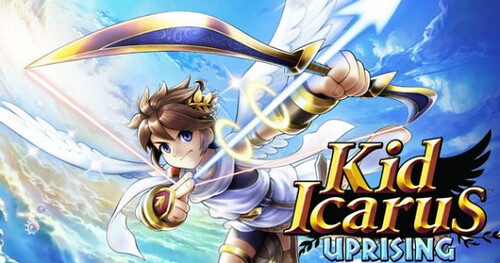
“The Fight is On!”
Kid Icarus: Uprising is the long-overdue
revival of a 25-year-old Nintendo franchise
starring the heroic angel Pit, the goddess
Palutena, and the evil Medusa. Aside from Pit
(who starred in Super Smash Bros. Brawl), those
names may not ring any bells – but in the glory
days of the NES, the angelic protagonist was
famous for dodging eggplant wizards and leading
the charge against the Underworld.
Though it has been over two decades since the
last installment, there was plenty of hype and
anticipation leading up to this release.
Fortunately, Masahiro Sakurai and his team at
Project Sora have dealt with that kind of
pressure before, and once again have responded
with something brilliant. Kid Icarus: Uprising
ultimately transforms the classic platforming
action of its predecssors into a hybrid of
exciting gameplay styles, going the extra mile
to offer what is arguably the deepest and most
content-heavy 3DS title to date.

“Steaming the Sacred Buns”
From the moment you see the menu screen in
Kid Icarus: Uprising, it is obvious that the
game was lovingly crafted by the same team that
built Super Smash Bros. Brawl. The interface is
nearly identical, and many of the extra replay
value-extending features are also included in
the game. I’ll discuss more of these things in
detail later; first I would like to break down
each of the game modes offered in Uprising, and
explain some of the depth of the game before
providing my critical opinions:
1. Solo Mode
The bulk of the single-player in Kid Icarus:
Uprising is played in “Solo Mode”, which tells
the story of the game throughout 25 stages, each
serving as a chapter in this 10- to 12-hour
tale. The start of each stage begins with a
flying section that lasts around five minutes
(there’s a reason for the time limit that is
explained in the story). These parts feel a lot
like Starfox 64 3D, with enemies and obstacles
bombarding Pit as he flies through the sky.
Using the stylus to aim and the circle pad to
move, your goal is to shoot as many bad guys as
possible. There is actually an “auto-fire”
option that makes the aerial combat much
simpler, if not too easy.
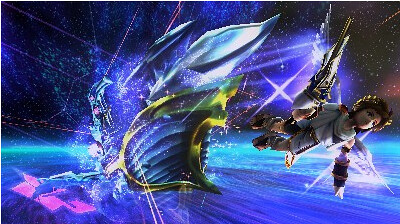
After a few minutes, Pit lands on the ground
of each level and begins fighting the Underworld
enemies on foot. At this point the game changes
completely, from the controls to the methods you
use to battle each foe. The on-foot areas of the
game are generally linear, sometimes throwing in
the occasional puzzle or platforming challenge
to keep things interesting. Overall, the game
starts to feel a lot like Ninja Gaiden or God of
War – nothing like the aerial segments, but
still a satisfying challenge nonetheless. You’re
forced to learn the various enemy patterns and
find their weak points – not to mention the wide
variety of weapons, from bows and blades to
claws and staves. There is a lot of depth and
strategy, far more than simply blasting away at
the on-screen enemies in the flying segments.
This split in the gameplay stlyes is important
to keep in mind, and I will touch on the subject
in more detail later in the review.
Each level concludes with a confrontation
against a boss character, testing your skill one
final time before the end-of-stage progress
screen rewards you with the hearts and spoils
for your efforts. The levels in Solo Mode can be
played with an adjustable “Intensity” setting
that ranges from 0.0-9.0. As you increase the
number, the quantity of enemies goes up along
with the speed of the game. On the other hand,
the rewards are also better – players snatch up
better weapons and powers, earn more hearts
(in-game currency), and find more power-up items
throughout each level if they actually test
themselves with the higher settings. You can
even find special areas in some levels that are
only accessible at certain difficulty levels;
each of these are generally loaded with goodies,
but also prove to be a tougher task than the
normal path. All things considered, the original
NES Kid Icarus was notoriously challenging and
unforgiving; playing Uprising on its higher
settings does a very good job of imitating the
brutal difficulty.
2. Together Mode
“Together Mode” is the nickname for the
multiplayer in Kid Icarus: Uprising, which is
actually loaded with a lot of options for those
who choose to invest in it. The game can be
played via WiFi or locally, with friends from
your 3DS Friend List or even just random players
from anywhere in the world. In addition to a 3-
versus-3 deathmatch mode, the star of the show
is the Light vs. Dark mode. In this game,
players on Light and Dark teams try to take each
other out and earn points until one combatant on
the each team turns into Pit or Dark Pit. From
there, that player is the “VIP”, and the winning
team is the one that protects him/her the
longest.

In general, the multiplayer content in Kid
Icarus: Uprising is almost like another whole
game on its own. It plays mostly like the
ground-based combat portions of the Solo Mode
and doesn’t include any aerial action, but it
ultimately extends the replay value to a very
large degree. It is easy to connect with
friends, set up groups, and play games –
everything you want from the online multiplayer
experience is here, and it all works very well.
Along with Mario Kart 7 and Resident Evil:
Revelations
, Uprising proves that there isplenty of fun to be had playing the 3DS online
with other players. Nintendo is finally “getting
it right” with online gameplay, and the depth
provided here – customized load outs, player
stats, a variety game modes – is indicitive of
that.
3. Extra Content: SpotPass, AR Cards and
More
In addition to its Solo Mode and the variety
of game types in Together Mode, Kid Icarus:
Uprising boasts a deep amount of extra content.
First, it utilizes the 3DS’s SpotPass and
StreetPass functions to give players the ability
to create, share, and fuse “Weapon Gems” using
weapons from Solo Mode. Sometimes, when you turn
the game on, you will randomly have a new weapon
gem from a SpotPassed player – this is always a
treat that can even lead to some of the game’s
most interesting weapon fusions.
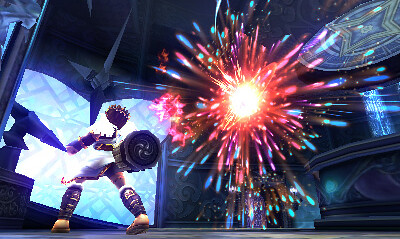
Moving on, Uprising is one of the first games
to make use of the 3DS’s “Augmented Reality”
feature, and comes packaged with a handful of AR
Cards that can be used to play a special little
game based around the AR Camera. Nintendo will
apparently release more of these AR cards over
time, and while I’m not sure that it will be the
most successful venture, the idea of playing
with the AR Cards is pretty novel on its own. I
have always wanted to see 3DS games use this
feature to a greater extent, and it is nice to
see someone finally making that push.
Finally, Kid Icarus: Uprising offers some of
the most extensive bonus content yet on the 3DS.
In addition to all the weapon-purchasing and
weapon-fusing that can be done with the hearts
you earn throughout the game (or the SpotPassed
weapon gems you collect), you will gradually
unlock more weapons and goodies through the
“Treasure Hunts”. These in-game Achievements
reward you with everything from hearts and
weapons to tracks from the music gallery and
“idols”, which are a lot like Super Smash Bros.
Brawl’s “trophies”, and provide more detail on
virtually every character, weapon, stage, and
enemy in the game. Even the 3DS “Play Coins” are
integrated into the game; you can use one Play
Coin to purchase an egg for the “idol toss”,
which is a mini-game that randomly rewards you
with more idols.
“You’re Not Ready Yet!”
Up to this point in my review, I have done my
best to avoid critical opinions, sacrificing
subjectivity for the sake of breaking down the
huge amount of content loaded onto the Kid
Icarus: Uprising cartridge. Now it is time to
change all of that – not only would I like to
point out some of my criticisms, I feel that I
should also touch on some of the impressions I
have heard from fellow players, or counter-
points I have found in other reviews of the
game. That being said, I believe…
1. …the ground-based areas in each level
are great – perhaps even better than the flying
parts.
As I mentioned earlier, the gameplay splits
between flying and ground segments after about
five minutes of mindless (but exciting) aerial
combat. This seems to be the top criticism of
Kid Icarus: Uprising in many different reviews,
and I think it is completely obnoxious. Although
there is definitely a learning curve associated
with the ground combat, such as mastering the
stylus-based camera controls and the touchy
dodge/dash abilities with the circle pad, I had
almost no trouble playing the on-foot portions
of each level. After admittedly struggling with
the ground controls for a few minutes in the
very first level, I adjusted the camera
sensitivity settings and slowly got more
comfortable with the circle pad, and had
absolutely no issues for the remaining 24
chapters.
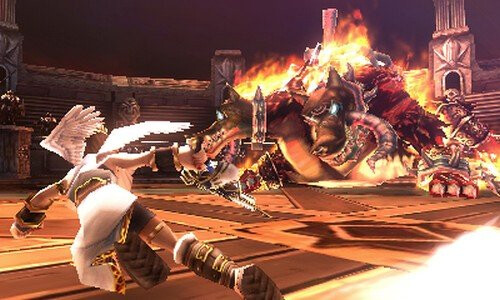
The ground portion of each stage is where the
depth of Kid Icarus: Uprising really begins to
shine. With all of the different weapon types,
the wide variety of enemies, and the focus on
weak points and attack patterns, there are so
many different ways to play and master the game.
If you enjoy long-range attacks, you can equip a
staff, bow, or blade and enjoy racking up the
kills from afar. If you like the up-close-and-
personal combat, claws and clubs are perfect for
wreaking havoc at short distances. The fact that
the game offers so much depth is great, but
actually providing a reason to dive in and
explore the content is even better. The flying
segments of Kid Icarus: Uprising are no doubt
fantastic – some are the most exciting parts of
the game – but the combat on foot is what made
me fall in love with the game, and I think the
critical response to this little learning curve
is pretty unfortunate.
2. …the in-game chatter between the cast
of characters is a brilliant way to unravel the
surprisingly intriguing plot.
Another big topic when discussing Kid Icarus:
Uprising seems to be the back-and-forth
bantering between the cast of characters in the
Solo Mode. Pit, Palutena, Medusa, and plenty of
other god-like characters and wacky figures come
into play throughout the game – there are
actually quite a few names to remember, and
plenty of events that happen over the course of
the adventure. I will try to avoid spoiling any
and all of those special tidbits for you in my
review, but let me say this: I think this form
of plot exposition is absolutely genius, and not
only works well in Uprising, but should be
explored more often in other games.
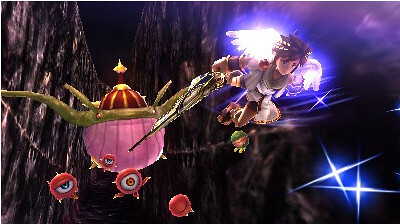
Rather than breaking up the action frequently
to hassle the player with cut-scenes, Kid
Icarus: Uprising channels most of its details to
the player in real-time. Although some critics
have called this “distracting”, I think it works
wonders for bringing out the personality of each
role, not to mention it keeps the time you spend
“watching” rather than “playing” to a minimum.
It is the opposite of Heavy Rain or Metal Gear
Solid 4; the developers of this game seem to
have been very intent on keeping you focused on
the action, rather than draining your 3DS
battery life with CG scenes that can’t be
skipped. All these things considered, the cut-
scenes that do pop up throughout Solo Mode are
done very well, using the 3D effect of the
handheld to its full potential.
Ultimately, the story in Kid Icarus: Uprising
ended up being one of my favorite parts – I was
attached to the cast, engrossed in the universe,
and excited about the franchise like never
before. I think a lot of this has to do with the
charming, light-hearted wit and sense of humor,
not to mention the plethora of references to the
Kid Icarus franchise and plenty of other classic
Nintendo titles (Mario, Metroid, Donkey Kong).
3. …the multiplayer is another huge step
forward for Nintendo and the 3DS.
Mario Kart 7 might have been the first big
step for online multiplayer on the 3DS, but Kid
Icarus: Uprising is possibly the biggest
achievement to date for any online Nintendo
title. I already mentioned that the Together
Mode and its various game types are a major part
of the package, but just thinking further about
the depth and amount of content, I feel like
Uprising makes a pretty bold statement about how
the Kid Icarus franchsie can evolve and continue
to innovate.
Remember, the online multiplayer is based
around the ground combat – and all of those
variables from Solo Mode come into play, from
the dodge mechanics and various weapon types to
the special powers equipped in each player’s
customized load-outs. The way you play really
determines your role in each match, and players
can begin to form strategies based on their
abilities. Having the option to play against CPU
opponents really helps you learn the maps and
familiarize with the fundamentals. Finally, I
feel like I would be committing some kind of
crime if I didn’t mention the mini-Practice Mode
that pops up between each multiplayer match.
Rather than waiting for a loading screen,
Uprising allows you to blast away at a training
target, which keeps you sharp and “in the mode”
during those intensive, extended playing
sessions.
“Floor Ice Cream Gives You Health!”
Kid Icarus: Uprising is, without a doubt, the
most “fun” that you can currently buy for $40
(or even $60). I would go further, even putting
it among the ranks of a “system-seller”; a game
that should firmly convince anyone on the fence
of buying a Nintendo 3DS to finally do so
without any hesitation.
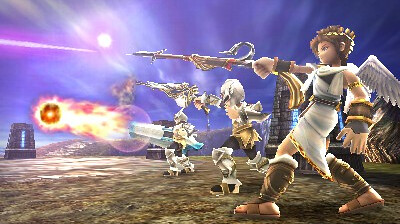
Although it is by no means a new franchise,
Uprising feels fresh and endlessly intriguing
from start to finish. The Kid Icarus franchise
has been so long forgotten that it almost feels
new again on the 3DS. For years, I wondered when
Nintendo could finally step up to the plate with
another name alongside its ranks of “Mario”,
“Metroid”, “Zelda”…With this installment, I
think “Kid Icarus” serves as the perfect choice.
The brand has been injected with depth and life
that it never had before, from the intangibles
(charming cast of characters, compelling
storyline, creative art style) to the most
fundamental mechanics (balance between
flying/ground combat, variety of
weapons/abilities, plethora of enemy types).
Ultimately, Pit’s universe is begging to be
explored, and by all means, Uprising serves as
the very best launching point for Kid Icarus to
take flight once again. I would really like to
see the series expand – thinking of both the
short-term (more AR cards? DLC for online
multiplayer?) and the long-term (sequel on 3DS?
WiiU?). Regardless, I am completely satisfied
with Pit’s return to form on the 3DS, and highly
encourage you to play it immediately.
| Graphics: | 9.5 |
| Sound: | 10 |
| Gameplay: | 9 |
| Creativity: | 10 |
| Replay Value/Game Length: | 10 |
| Final: | 9.7 out of 10 |
| Written by Cliff Bakehorn | Write a User Review |